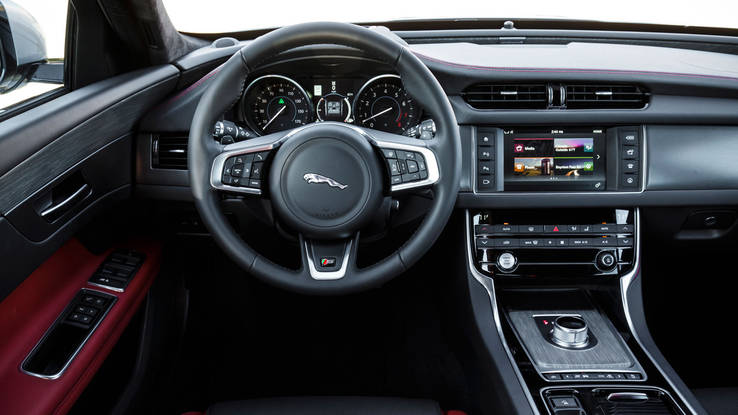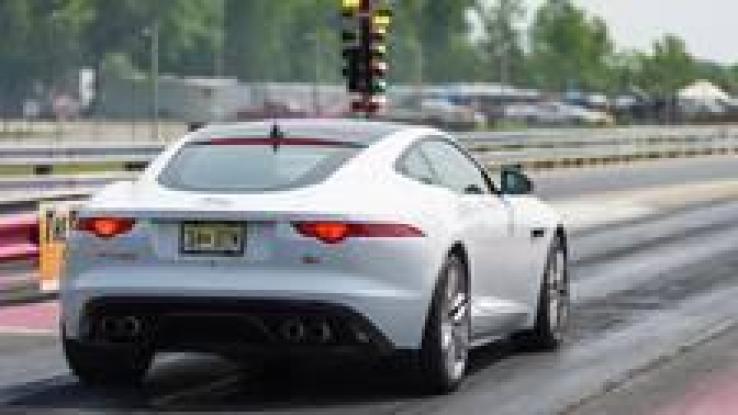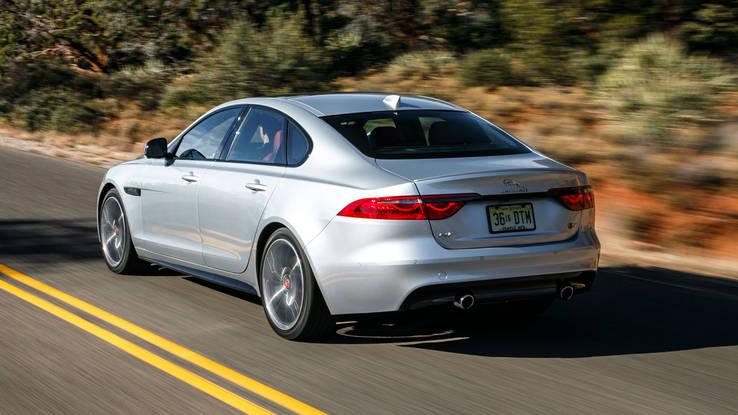Sexy second-gen sedan makes its case for your midsize luxury dollars
Ian Callum joined Jaguar in 1999, refreshing some of the brand’s aging designs like the X-Type and S-Type. But the Scot really didn’t hit his stride until 2006 when the Aston Martin-lookalike XK coupe debuted. He followed that hit with the 2008 XF sedan and has been on a design roll ever since. We’re now eight years from that sedan and the XF is entering its second generation a little meaner, a little tauter and a little lighter all around.
The front air intakes are bigger. The head and taillights are more stylized. The sheetmetal is pulled tighter and the whole package looks both more aggressive and more luxurious. The XF name now runs the gamut from the supercharged XF 35t Premium ($ 51,900) up to the XF S AWD ($ 65,700). We tested the XF S rear-wheel drive model, which stickers for $ 62,700 and is on sale now.
The S at the end of the name denotes an upgrade in power. The base cars get 340 hp and 332 lb-ft of torque from a supercharged V6 while the upgraded versions come with a 380 hp version of the same 3.0-liter V6 mill. An eight-speed automatic distributes thrust.
The XF S is car that doesn’t need anymore power. The last 550-hp R version is sweet, and faster and louder. But you won’t need it. A friend and I were cruising down the highway, discussing whether he needs to find a car with a V8 or could settle with a six. I hit the smashed the gas said, “C’mon, do you need more than this?”
Throttle tip in is sort of hit and miss. In race mode with the gearshift dial tuned to S, it’s too touchy, and hard to take off smoothly. In normal mode and D, it’s a little too numb. Switching one but not the other seemed to be a good fix. Once you get going, though, power delivery seems very linear.

A new infotainment system makes living with the XF much easier.
I found the pedals a little too close together. When I’d pivot my foot from the gas I’d hit both, which would be less of a problem if the pedal heights weren’t so close too. More than once I found myself braking but also revving the engine as I came to a stop.
Another issue I have is with the emergency braking system. It flashes a red triangle on the windshield when it thinks you’re approaching too fast, but it seems to kick in as soon as the car in front slows at all. Of the ten times it went off over the weekend, only once did I actually need to go to the brakes.
Shifts from the eight-speed are smooth with just a little kick, and surprisingly fast for a torque-converter car. I guess it’s not so surprising. The F-Type is the same way. You have to really put your foot down to hear some engine noise in the high revs, but it’s worth it so try it a few times.
In the cabin, the Jag is mostly isolated from the road. The winter tires might add a little noise, but performance from the Pirelli Sottozeros were spectacular at a frigid 10 degrees Fahrenheit, which is what the temperature was for the entire weekend. I hit one big pothole that made me wince, the rest were absorbed.

Long-term wrapup: 2015 Jaguar F-Type R Coupe
We wanted to do something cool with our long-term 2015 Jaguar F-Type R before we begrudgingly sent it back after a year in our fleet. We settled on drag racing, something we’d been doing …
The XF S has a nice, boosted steering setup that’s quick and responsive, but I think the winter rubber took some of the feel away. Changes of direction are fast and without any real body roll, which I love, but I’m not sure the average Jag XF buyer wants such a stiff suspension. When I think Jaguar, I think soft and comfortable, and a little powerful. This would probably fall second in sportiness in the midsize, luxury sport sedan segment, behind the 5-Series but ahead of the Mercedes and Audis of the world.
And that’s where it would fall for me personally as well. On second thought, it might even be my first choice. There’s something about what a Jag says about you, as opposed to what one of the Germans would say. The Germans say, “I have money, and if you have money then you’re supposed to buy a German luxury car.” The Jag says, “I can afford any midsize luxury car, but I want something that’s a little different than your mainstream tech yuppie.” Sales numbers bore that out. In 2015 Jaguar sold about 6,000 XFs, BMW sold about 45,000 5-Series.
Inside, this XF S feels more sport than luxury. The dash, doors and center console are a mishmash of materials and colors, including matte wood, piano black, carbon fiber and leather. It’s busy to the eye, but I think it works. The new, or possibly upgraded, radio is way better than the last version, quicker to act and looks more upscale as well. And those flip-out climate vents are always sweet.
The Jag, the BMW 5-Series, the E-Class and the Audi A6 are all close competitors. Starting prices range from $ 47-$ 53k for the whole lot. Throw the Lexus GS in that mix too. I haven’t taken any to the track besides the 5-Series, but I wouldn’t be surprised if this XF gave it a run for its lap time money. It’s certainly the sexiest of the five.
–Jake Lingeman, Road Test Editor

The XF S gets an extra 40 hp for a total of 380 hp.
OTHER VOICES:
Jag’s midsize sedan feels remarkably German inside, and it should, as it is aimed squarely at Team Deutschland. The cabin has that same hard but efficient feel, the controls are heavy yet very precise, and the chassis feels stiff. Those more familiar with Jaguar’s offerings from fifteen years ago will find themselves in a different type of car than they’re used to. Of course, that’s partially due to the fact that fifteen years ago Jaguar only had one real Jaguar sedan, and also one Ford Mondeo wearing some polarizing bodywork. The current XF may as well be decades ahead of those offerings (and it is), offering a distinctly different experience in its approach to “luxury motoring,” as they say in its homeland.
My time in the XF S coincided with some wintry Michigan commutes and I didn’t get to open it up on zee autobahn, so I spent my time paying attention to the cabin and driving dynamics at city speeds.
The XF S manages to combine a stiff and agile chassis with reasonably communicative steering — this is still a luxury sedan, not a rally rocket — as well as confidence-inspiring brakes and a reasonably cushy cabin. The cabin offers very ergonomic seats with just a dash of premium materials — this is a Jag that doesn’t go overboard on leather surfaces wood veneers, but instead tries to outdo the Germans in its own way.
The handling is remarkably well rounded with the suspension erring on a sportier feel, but one that never really dips into harshness. This is a Jag that doesn’t roll in the corners, and even though there is plenty of sedan around me the car felt far nimbler than its intended BMW 5-Series and Mercedes-Benz E-Class rivals. The Jag hides its size well, and on just about every occasion that I drove the car I noted that its agility is closer to cars living a full size segment below it. The dimensions of the bodywork are certainly there, but this is a sedan that is very quick on its feet. The most surprising aspect of the car’s behavior and controls was the response of the accelerator — it felt a bit touchy and rev-happy at slow city speeds.
I liked the steering in this car, but I have to admit it was a little on the numb side (those used to driving big Audis will know that feeling). I also liked the fact that the design of the interior does its own thing and does not feel inclined to imitate others — the “bathtub rim” that surrounds the cabin at window sill height is a nice stylistic element that adds to the cocoon-like feel of the cockpit. Everything on the dash feels with easy reach which is something that seems to elude other automakers from time to time, specifically those who position infotainment screens way too high and too far away from the driver. The Jag’s center stack retains plenty of buttons, including on the steering wheel itself, so those drivers who start twitching at the sight of an iDrive-like knob that controls everything should like this interior.
–Jay Ramey, Associate Editor
Options: driver assistance pack including adaptive cruise control, AEB with queue assist, proximity camera system, traffic sign recognition and park assist ($ 3,100); luxury interior upgrade pack including electric rear sunblind, manual side rear blinds, four-zone climate control, 10 color ambient lighting, suede cloth premium headliner and illuminated door sill finishers ($ 2,700); comfort and convenience pack including cooled front seats, heated rear seats, soft door close and power trunk close ($ 2,000); Labyrinth alloy wheels ($ 1,000); head up display ($ 900); rhodium silver metallic ($ 550); black pack ($ 320); fine line veneer ($ 300)



























